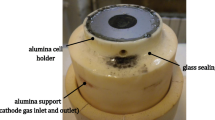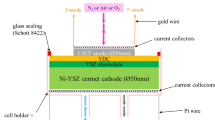Abstract
Three solid oxide cells have been investigated after long-term high temperature electrolysis to explain the phenomena of accelerated degradation. These cells contain a Ni-YSZ cermet (Ni-yttria-stabilised-zirconia) as hydrogen electrode (cathode), yttria-stabilised-zirconia (YSZ) as electrolyte, Ce0.8Gd0.2O1.9 (CGO) as diffusion barrier layer and La0.58Sr0.4Co0.2Fe0.8O3 (LSCF) as oxygen electrode (anode). Cell 1, cell 2 and cell 3 were tested continuously at about 770 °C, with a current density of −1 A cm−2 and 80 % H2O of absolute humidity for 9000, 1770 and 1460 h, respectively. It was found that in cell 1, the degradation rate was about 2.2 % per 1000 h, in cell 2 the degradation rate increased to 3.4 % per 1000 h and in cell 3 the degradation rate was 2.6 % per 1000 h. The mode of cell degradation was also investigated as a function of the cell fabrication in the four layers system (anode/diffusion barrier layer/electrolyte/cathode). An intergranular fractured surface along the grain boundaries of the electrolyte, and the formation of porous structures throughout the thickness of the electrolyte were observed in cell 1. LSCF, as the oxygen electrode, showed compositional fluctuations with a changed perovskite composition and formation of cobalt oxide. This phenomenon reduces the electrical conductivity and, probably, also the catalytic properties. The hydrogen electrode did not show major changes in all the three cells tested. Cells 2 and 3 showed similar features as observed for cell 1, except the fact that they retained the electrolyte structure without intergranular fracture and formation of porosity after continuous testing for long duration.





Similar content being viewed by others
References
Hauch A, Jensen SH, Ramousse S, Mogensen M (2006) J Electrochem Soc 153:A1741–A1747
Menzler NH, Tietz F, Uhlenbruck S, Buchkremer H-P, Stöver D (2010) J Mater Sci 45:3109–3135
Jacobsen T, Mogensen M (2008) ECS Trans 13(26):259–273
Martin M (2000) Solid State Ionics 136–137:331–337
Knibbe R, Hauch A, Hjelm J, Ebbesen SD, Mogensen M (2011) Green 1:141–169
Tietz F, Sebold D, Brisse A, Schefold J, Power J (2013) Sources 223:129–135
Mai A, Haanappel VAC, Uhlenbruck S, Tietz F, Stöver D (2005) Solid State Ionics 176:1341–1350
Haanappel VAC, Bär B, Tropartz C, Mertens J, Tietz F (2010) J Fuel Cell Sci Technol 7:061017
Schefold J, Brisse A, Tietz F (2012) J Electrochem Soc 159:A137–A144
Moçoteguy P, Brisse A (2013) Int J Hydrog Energy 38:15887–15902
Acknowledgments
The work was financially supported by the Federal Ministry of Economics and Technology under contract no. 03ET2014.
Author information
Authors and Affiliations
Corresponding author
Rights and permissions
About this article
Cite this article
Al Daroukh, M., Tietz, F., Sebold, D. et al. Post-test analysis of electrode-supported solid oxide electrolyser cells. Ionics 21, 1039–1043 (2015). https://doi.org/10.1007/s11581-014-1273-2
Received:
Revised:
Accepted:
Published:
Issue Date:
DOI: https://doi.org/10.1007/s11581-014-1273-2




